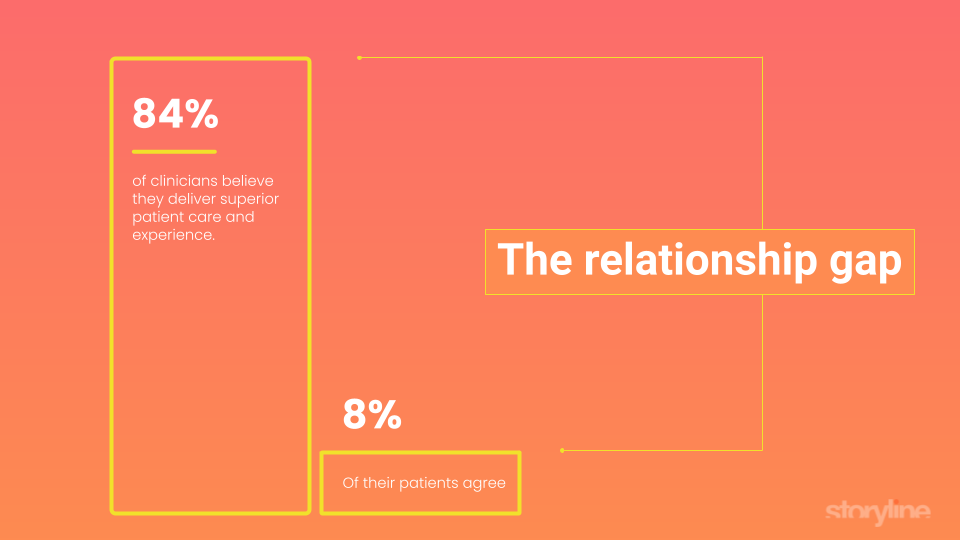The Subscription Business Model: Patient churn is killing your clinic’s profitability.
/The single most important determining your success and profitability is how well you do one thing; create value for your patients.
Most providers don’t actually understand that sentence very well. They see ‘value’ as the effort they put in to provide good medical advice – but that’s just a tiny part.
When you don’t provide value and build relationships in the ways that your patients want – especially in cosmetic medicine – they’ll drift off for greener pastures – and that loss (patient churn) destroys the long term value of your business.
Here are the numbers.
The gap is just as wide in cosmetic medicine as in other areas because it’s competitive. The fact that your staff is friendly and offer free sparkling water is no longer enough to set you apart. It’s expected, and discounted as a basic requirement.
So what can you do to set your clinic apart in what’s become a hyper-competitive marketplace.
That’s actually simple to understand, but difficult to work through – you need to do the things that patients want AND that your competitors are unable or unwilling to do.
That is NOT EASY, because the top 3 things patients want demand TIME – and you don’t have any.
Here’s what patients want:
And you can’t deliver what patients want because you can’t simply work more hours and spend more time without impacting your practice and profitability.
There’s a reason that you’re working 70 hours a week but only spending 27% of that time working at the top of your licence.
Fortunately, there are now technologies that are coming into the market that let you automate much of the time-sucking, redundant manual tasks that keep you doing everything manually.
First, telehealth came along. That was good but all of the first telehealth solutions were built around insurance reimbursements. That meant that they were manual too, and didn’t save you any time as a provider. Patient’s no longer had to drive to your clinic and sit in your waiting room, but they didn’t really save you time as a provider – you were just trading 15 minutes in a treatment room for that same 15 minutes on a video call.
You added during Covid but you’re probably using a free telehealth service like Skype or Zoom, or a slightly upgraded version like Doxy, and none of these solve the base problem; there’s only 1 of you and you can’t be in 10 places at once.
Fortunately, technology doesn’t sit still.
The newest telehealth platforms integrate both your in-clinic care with on-demand access that allow you to automate almost all of the myriad of things you’re doing that are completely redundant and manual.
These new technologies were built for large health systems and clinical trials, but have become available to smaller clinics and individual providers, and they solve exactly the problems you need solved; How do I replace the low-level redundant tasks with automation in the ways that patients love.
Read that last sentence again because it’s important. The technology has to be loved by the patients, not just be another hoop to jump through.
These new technologies were designed outside of the insurance reimbursement ecosystem. They were designed for clinical trials and drug discover where it’s critical for patients to be engaged and love interacting with caregivers. The average cost of 1 patient in a clinical trial is now $3,600! There’s no way you can afford to lose patients in these ecosystems or you’re dead in the water.
And that’s exactly the problem you have.
These new platforms allow you to create ‘care pathways’ that automate any use case; new patient onboarding, triage, treatment, followup.. whatever you want. Best of all, your patients don’t differentiate between interactions on these new systems and live interactions. You can build these care pathways, and you can charge for them.
That means that you really can be in 100 places and once.
And because you can built it once and charge for it over and over, it opens up entirely new revenue streams and business models that allow you to scale your practice and business in ways that haven’t ever been available before.
Here’s what this looks like as recurring or subscription revenue over time.
If you’re interested in creating subscription or recurring revenue for your cosmetic practice or medical spa, you can learn more here.
Links if you want to dive in further:
Advisory Board. (2018, February 12). Your staff is underperforming. Now what? Retrieved from https://www.advisory.com/daily-briefing/2018/02/12/c-performers
Bailey, D. (2017, June 27). Unicom Teleservices, Inc. Retrieved from https://www.unicomcorp.com/blog/tips-to-increase-medical-practice-profits/
Brinker, B. (2017, November 26). 10 Warning Signs of a Disengaged Employee. Retrieved from https://www.aventr.com/blog/10-warning-signs-disengaged-employee
Carter, A. (2012, March 20). Front Desk Profits. Retrieved from https://empoweringyouconsulting.com/2012/03/20/front-desk-profits/
Easy Pay. (2014, October 16). Patient Payments Blog. Retrieved from http://www.easypaycollect.com/blog/5-front-office-staff-best-practices
Gooch, K. (2016, April 26). Patients' No. 1 complaint? Front-desk staff. Retrieved from https://www.beckershospitalreview.com/hospital-management-administration/patients-no-1-complaint-front-desk-staff.html
Hamilton, K. (2017, November 18). 7 Surprising Reasons Why Your Medical Staff is Unhappy. Retrieved from https://getreferralmd.com/2013/09/medical-staff-employment-tips/
Nijjer, R. (2018, August 29). How Negative Reviews Impact SEO. Retrieved from https://www.searchenginejournal.com/how-negative-reviews-impact-seo/265991/
Quora. (2018, April 26). Why Soft Skills Are So Important For Medical Professionals. Retrieved from https://www.forbes.com/sites/quora/2018/04/26/why-soft-skills-are-so-important-for-medical-professionals/
Russell, P. (2016, October 13). Do Receptionists Keep Some Patients From Medical Care? Retrieved from https://www.medscape.com/viewarticle/870272
Sinsky, C. (2008, October 01). 10 Big Ideas That Could Make Your Practice Better. Retrieved from https://www.aafp.org/fpm/2008/0900/p33.html
Thomas, C. (2017, August 11). 11 Tips to Create a Profitable Front Desk at Your Salon Spa. Retrieved from https://www.linkedin.com/pulse/11-tips-create-profitable-front-desk-your-salon-spa-chris-thomas/
Vanguard Communications. (2017, November 10). Online Doctor Complaints Primarily About Customer Service | Vanguard. Retrieved from https://vanguardcommunications.net/patient-complaints/
Wiggins, K. (2017, March 16). How employers 'manage out' unwanted staff. Retrieved from https://www.ft.com/content/356ea48c-e6cf-11e6-967b-c88452263daf













